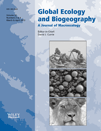View Item
- xmlui.general.dspace_homeCentros Regionales y EEAsCentro Regional Patagonia SurEEA Santa CruzArtículos científicosxmlui.ArtifactBrowser.ItemViewer.trail
- DSpace Home
- Centros Regionales y EEAs
- Centro Regional Patagonia Sur
- EEA Santa Cruz
- Artículos científicos
- View Item
Estimates of soil carbon concentration in tropical and temperate forest and woodland from available GIS data on three continents
Abstract
Aim: Concern about climate change, with the subsequent emergence of carbonmarkets and policy initiatives such as REDD (reducing carbon emissions bydecreasing deforestation and forest degradation), have focused attention on assess-ing and monitoring terrestrial carbon reserves. Most effort has focused on above-ground forest biomass. Soil has received less attention despite containing morecarbon than above-ground terrestrial biomass and the atmosphere
[ver mas...]
Aim: Concern about climate change, with the subsequent emergence of carbonmarkets and policy initiatives such as REDD (reducing carbon emissions bydecreasing deforestation and forest degradation), have focused attention on assess-ing and monitoring terrestrial carbon reserves. Most effort has focused on above-ground forest biomass. Soil has received less attention despite containing morecarbon than above-ground terrestrial biomass and the atmosphere combined. Ouraim was to explore how well soil carbon concentration could be estimated on threecontinents from existing climate, topography and vegetation-cover data
Methods: Soil carbon concentration and leaf area index (LAI) as well as GIS-derived climate and topography variables for 65 temperate and 43 tropical, forestand woodland ecosystems, were either directly measured or estimated from freelyavailable global datasets. We then used multiple regressions to determine how wellsoil carbon concentration could be predicted from LAI, climate and topography ata given site. We compared our measurements with top soil carbon estimates fromthe Food and Agriculture Organization of the United Nations (FAO) harmonizedworld soil map.
Results: Our empirical model based on estimates of temperature, water availabil-ity and plant productivity provided a good estimate of soil carbon concentrations(R2= 0.79). In contrast, the values of topsoil carbon concentrations from the FAOharmonized world soil map correlated poorly with the measured values of soilcarbon concentration (R2= 0.0011).
Main conclusions: The lack of correlation between the measured values of soilcarbon and the values from the FAO harmonized world soil map indicate thatsubstantial improvements in the production of soil carbon maps are needed andpossible. Our results demonstrate that the inclusion of freely available GIS dataoffers improved estimates of soil carbon and will allow the creation of moreaccurate soil carbon maps.
[Cerrar]

Author
Ladd, Brenton;
Laffan, Shawn W.;
Amelung, Wulf;
Peri, Pablo Luis;
Silva, Lucas C. R.;
Gervassi, Pina;
Bonser, Stephen P.;
Sheil, Douglas;
Navall, Jorge Marcelo;
Fuente
Global ecology and biogeography 22 (4) : 461–469. (2013)
Date
2013-04
ISSN
1466-8238
Formato
pdf
Tipo de documento
artículo
Palabras Claves
Derechos de acceso
Restringido
 Excepto donde se diga explicitamente, este item se publica bajo la siguiente descripción: Creative Commons Attribution-NonCommercial-ShareAlike 2.5 Unported (CC BY-NC-SA 2.5)
Excepto donde se diga explicitamente, este item se publica bajo la siguiente descripción: Creative Commons Attribution-NonCommercial-ShareAlike 2.5 Unported (CC BY-NC-SA 2.5)

